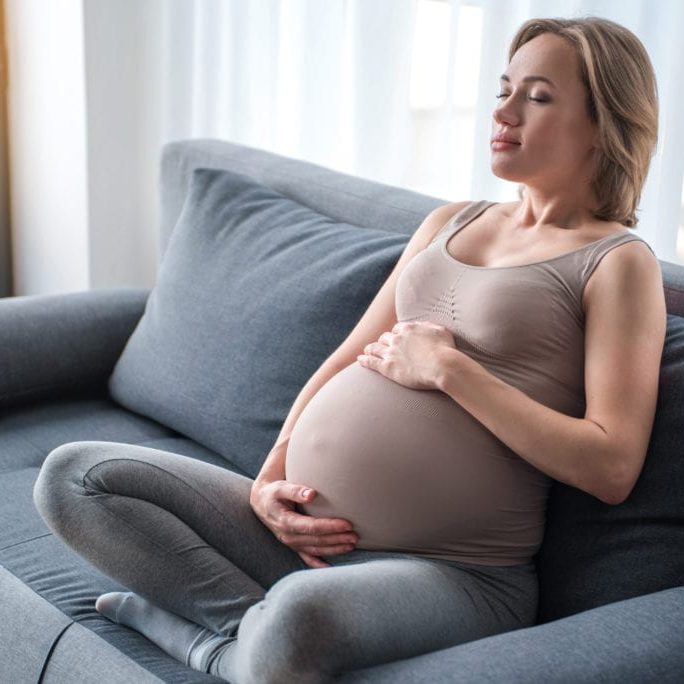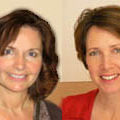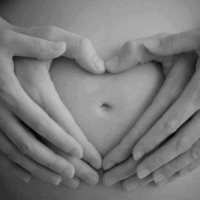What is Swedish HypnoBirthing?
HypnoBirthing is a philosophy and a set of techniques that prepares parents for a natural, gentle birth. It teaches a program of deep relaxation, visualisation and self-hypnosis which then promotes a calm pregnancy and a trauma free birth.
The HypnoBirthing process is taught over a series of 5 classes with a certified HypnoBirthing practitioner. Each class gives the mother and birth partner techniques to manage the birthing process. Education is an important part of the HypnoBirthing classes as it's through dispelling myths and fear based stories that the mother can embrace childbirth as a calm, peaceful and natural event.

HypnoBirthing was founded by Marie Mongan of Chichester, New Hampshire. She is a mother of four adult children and experienced labour without any medication after becoming interested in the works of two natural birth pioneers; Dr. Jonathan Dye, from Buffalo, New York and Grantly Dick-Read of the UK. Mongan combined the research from these natural birth advocates with her counselling and hypnosis training to develop HypnoBirthing.
What to expect from a HypnoBirthing Session
HypnoBirthing classes are taught in a series of five 2 1/2 hour classes, usually with only a small number of couples present. Each class prepares the parents for a safe and comfortable birth experience.
During the first class the aim is to build a positive birth expectancy. The philosophy behind HypnoBirthing is explained along with the background of women and childbirth. The HypnoBirthing practitioner explains how women's bodies are perfectly designed by nature for childbirth and how natural birthing instincts should be assisted and not resisted. Visualisation of a gentle, natural birth is assisted by viewing peaceful birthing videos.

The second class teaches pre-natal bonding techniques and focuses on preparing the mind and body for birth. Successful breathing techniques during labour are given along with techniques to aid self-relaxation and visualisation. The importance of selecting the right care provider and the role of the birth companion is discussed. Tips on helping the mother to prepare for birth with massage and toning are given.
During the third class the emphasis is on getting ready to welcome the new arrival. It teaches how to prepare birth preference sheets and how to prepare the body for birthing. Light touch labour massage is also taught, as is how to make the body work for you during labour. Information is given on how to avoid artificial labour induction and how to start labour naturally without medical intervention. The HypnoBirthing practitioner helps the parents release negative emotions, fear and limiting thoughts surrounding the birth process.
The fourth class centres on the labour process. It explains what happens to the woman's body as labour progresses and what can be done to make sure the natural birthing experience is protected. A birth rehearsal imagery is given during this class.
The final HypnoBirthing class focuses on the actual birth. It guides parents through the final stages of labour and the birth of the baby, teaching the mother to breath the baby down to birth. Bonding with the newborn baby and moving the baby to the breast are also included in this class.
Effects and Benefits of HypnoBirthing
One of the main benefits of using HypnoBirthing is the reduction in pain during childbirth. Re-eduction of childbirth is an integral part of the teaching as it allows the mother to see birth as a natural, calm process rather than a pain-filled trauma. Eliminating this fear coupled with self-hypnosis, breathing exercises and visualisation techniques brings pain levels down significantly. It's been shown that 40% of mothers using HypnoBirthing give birth without any pain relief and a further 37% use only gas and air (entonox) to manage pain. The first stage of labour is often shorter, on average by 2-3 hours, for mothers using HypnoBirthing.
By using self hypnosis techniques to keep calm and relaxed it helps the mother's body in producing natural painkillers, beta endorphins, during labour. It also reduces the production of adrenaline, the 'fight of flight' hormone that gets released when a person is scared. Adrenaline interferes with oxytocin, the major hormone released during labour, and can slow down contractions and starve the uterus of oxygen which in turn produces a slower labour and an increase in pain.
There is less medical or surgical intervention in births using HypnoBirthing. Parents are taught to be confident and in control so they can make decisions throughout labour and birth. If intervention is deemed necessary parents have the skills to remain calm.
The father or birth partner is an active member of the birth party and contributes to the birth of the child.
It's been observed that babies delivered with HypnoBirthing techniques appear calmer and more settled immediately after birth. Mothers have a shorter post-partum recovery time and they suffer less with post natal depression.
The self hypnosis skills learnt through HypnoBirthing can be used at any time, for any situation when it's necessary to remain calm and in control.
These are ten of the main claims made for HypnoBirthing; that it:
- Reduces the time the mother is in labour.
- Takes away the fear of childbirth.
- Significantly lessens the pain felt during labour and childbirth.
- Has a high number of natural births with no technical or surgical assistance.
- Boasts an 81% success rate in turning breech-presented babies in the late stages of pregnancy (source: University of Vermont).
- Can be used effectively with all choices of childbirth such as home births, water births, at birthing centres or in hospital.
- Empowers the parents to be calm, confident and in control during the birthing process.
- Reduces the risk of an episiotomy, and the need for stitches.
- Lessens the need for any medication.
- Provides a quicker post natal recovery for the mother.
Professional Bodies & Organisations
The HypnoBirthing Association
The association welcomes professionals from all branches of hypnobirthing and natural birth practices. Its focus is to promote natural birthing techniques as well as standards for quality hypnobirthing training and practice.
Independent Midwives (UK)
A professional organisation for qualified midwives who have chosen to work outside of the NHS. They provide continual, individual services in both ante natal and post natal care. This organisation encourages women led choices in childbirth and often the independent midwives have extra qualifications in complimentary therapies such as HypnoBirthing.
HypnoBirthing – The Mongan Method (International)
The official HypnoBirthing institute, by HypnoBirthing founder Marie Mongan, provides training and certification programs for those interested in providing HypnoBirthing services. The Institute maintains a list of certified HypnoBirthing practitioners throughout the world.
Fascinating Facts
- During 2011, the NHS is looking into the benefits of using HypnoBirthing as part of its ante natal care for women. Trials of 800 pregnant women are taking place in Manchester.
- Hollywood actress Jessica Alba gave birth to her first child, Honor Marie, in 2008 using HypnoBirthing techniques and is planning on using it again during the birth of her second child due in 2011.
- Supermodel Gisele Bundchen claims she had a pain free birth of her son due to using self-hypnosis techniques.








